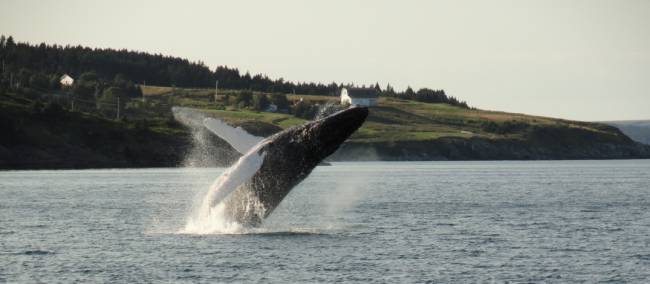
A whale breaches off the east coast of Newfoundland | Newfoundland and Labrador Tourism
By Robin Esrock
There’s a lot of information about whales, but little of it explains why seeing one is so memorable. Perhaps it’s because of their size, which is tough to discern unless a humpback or orca happens to gift us a rare but spectacular breach. Perhaps it’s because they’re mammals, not fish, and therefore notably intelligent and highly social. Maybe it’s because of the stories we tell about whales, from Jonah to Moby Dick, Pinocchio to Free Willy. Or perhaps it’s because this graceful, unique creature was almost hunted to extinction, reminding us of human cruelty, the fragility of nature, and how close we all come to the brink. Regardless, chances are high you’re going to see a whale when visiting Newfoundland in summer or hiking the West Coast Trail on Vancouver Island. Let’s learn a little more about what, in fact, you might see.

An estimated thirty whale species are migrating along Canada’s 200,000 kilometres of shoreline. Our most common whale-watching rock star is the humpback, renowned for its seasonal migrations, loud fin slaps, distinctive hump and full body breaches. Growing up to 19 meters (62 ft) long and living up to 90 years of age, Megaptera (the humpback’s fancy Latin name) are common off the coast of Newfoundland and British Columbia during summer months. When you see a large whale off the coast during the East Coast or West Coast Trail, it’s likely a humpback migrating from the Caribbean or returning from Mexico or Hawaii. That said, it could also be the smaller, fast-moving, abundant minke whale. Minke whales can stay underwater for up to 15 minutes without needing a breath and seldom show their flukes (tails). Although they’re the smallest baleen whale, they still grow up to 10.6m long and weigh 9 tons, so you won’t be confusing them with dolphins or porpoises. Be grateful they’re not spouting close to you on the water; there’s a reason they’re known as Stinky Minkes!

Humpbacks and minkes may be common, but it’s not uncommon to spot other whale species off both coasts. On the East Coast, these include pilot whales, North Atlantic right whales, orcas, and the elusive fin whale (second only to the blue whale in terms of size). Off Vancouver Island, you might encounter both resident and transient orca populations, along with gray whales and fin whales. How will you know what kind of whale you’re looking at? If you’re a marine biologist, there are very clear signs that relate not only to the species but the individual as well. For the rest of us, try and discern the size and shape. When surfacing, humpbacks have a dorsal fin towards the back and pop out the water quite a bit, sprouting with a large cloud of spray. Minke whales look similar but a lot smaller and seldom spout at all. Fin whales will be longer with a more pronounced fin and a taller, ice-cream cone-shaped spout. Orcas are perhaps the most distinctive of the toothed whales with their upright dorsal fins, flat spouts and clear markings.

You’ll know if you’ve seen a beluga whale by their distinctive colour (the word beluga comes from “white ones” in Russian), their melon-shaped heads, and if you’re close enough, by the distinct vocalizations of a whale known as the canaries of the sea. Belugas swim south from the Arctic each summer in Canada as far south as the St Lawrence Estuary in Quebec, passing the East Coast of Newfoundland along the way. In truth, by the time you start looking for clues about what you’re seeing, the whale will likely have submerged again, so enjoy the moment and let your guide fill you in later.
A handy trick to spot whales is to scan the horizon for anything unusual. Merely looking at the water can be hard with the contrasts, and just like the abundance of ‘rock lions’ on safari, you’ll likely see plenty of ‘wave whales.’ See if any birds are flying overhead, often drawn to the same prey the whale is hunting, and there might be whale-watching or fishing boats enjoying the scene too.

Of course, like all wildlife, there’s no guarantee you’ll see anything. I’ve been on whale-watching excursions that guaranteed a 99.9% chance of seeing whales, and somehow find myself in the 0.1% zone (or the victim of dubious marketing!) My very best whale-watching experiences were spontaneous and unplanned for. On a small fishing boat off the coast of Newfoundland, a pod of orca encircled us for about fifteen minutes. I remember the bull’s dorsal fin being taller than me and the look, however brief, of a curious eyeball gazing back at us just feet away from the edge of the boat. It left me in no doubt whatsoever that these are intelligent, playful and curious creatures, and it was a bucket list thrill to have that encounter.
Whether you happen to see a whale up close in the distance or not at all, just knowing they’re out there, spouting and diving, breaching and singing their songs, make any outdoor coastal adventure all the richer and more rewarding.
Whale Watching in Newfoundland
Along with opportunities to see whales along the East Coast Trail or with GCT’s Vikings, Whales and Icebergs itinerary in Quirpon Island, you can also take popular whale-watching excursions from St John’s, Twillingate, the Witless Bay Ecological Reserve and Bay Bulls along the Avalon Peninsula.
Whale Watching in British Columbia
Summer on the West Coast attracts plenty of whale-watching visitors, hopping on boats from harbours in Vancouver, Steveston, Victoria, Tofino, and further north in Telegraph Cove and Prince Rupert. The whale watching season typically runs from May to October.